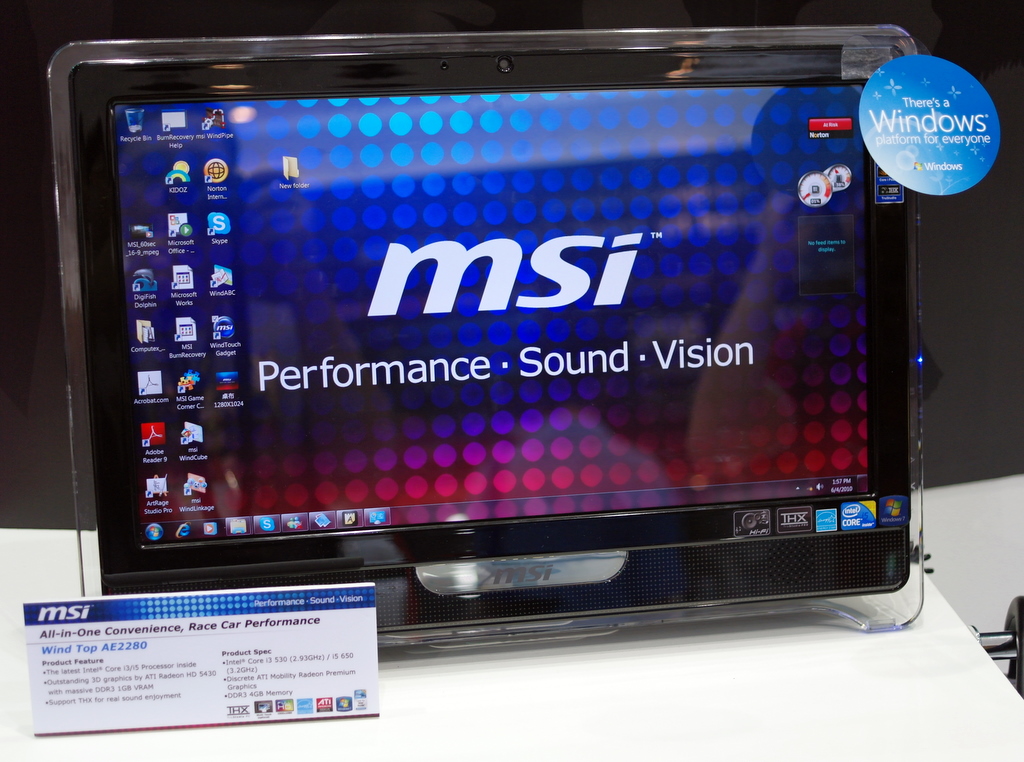Touchscreen PCs: 3 Things to Change
As we finally tried out the MSI Wind Top AE2280 (available at the company's COMPUTEX 2010 booth), three badly needed changes to Windows touchscreen PCs came to mind.
Always provide enough resources for responsiveness
MSI's offering was powerful enough to respond immediately to user touch-input. Why shouldn't it be, with at least a Core i3 530 and 4 GB of DDR3 memory? However, not all tablet PCs however are that responsive. The Lenovo ST10-3t we tried out was a very compact 10" swivel tablet PC, but with only 1GB of RAM onboard, many touch commands suffered from interface lag.
For a touch interface to be truly useful, it has to react immediately. Once the user taps, something should instantly happen. Companies shouldn't release tablet PCs that don't have the hardware required for a responsive user experience.
Build more fuzzy logic into the system
Users are notoriously imprecise and inconsistent, which is why interface systems shouldn't be too obsessive-compulsive. The Wind Top's touch controls are similar to Apple's "original" system, but some gestures need a relatively inconvenient degree of precision before working properly. In other words, we sometimes had to do our gestures "properly" to get the Wind Top to recognize them. That took us longer that we liked, so we unconsciously reached for a mouse and keyboard once again.
While randomly moving your fingers around a touchscreen shouldn't result in anything, perhaps the detection system should be a little more forgiving?
Get Tom's Hardware's best news and in-depth reviews, straight to your inbox.
Get rid of those damn raised bevels!
True tablet PCs, the ones that are basically digitized slates, get it right: make the display flush with the supporting frame so that people have more space to tap their fingers on. At the same time, this makes it much easier to tap items on the corners of the display. The user doesn't have to take care to keep their finger away from the bezeling as much as possible in this configuration.
So why do PC manufacturers like MSI and Lenovo insist on the classic monitor configuration, with the surrounding raised slightly relative to the actual screen? Make everything one flat plane, and tapping everywhere becomes much easier.
What about you?
How has your experience with Windows touchscreen PCs been? Whether or not you think it needs improving, feel free to share your comment below.
-
ricardok To me, touch PCs aren't really attractive. I still love my mouse/keyboard combo. I do own an iPod Touch and a Motorola Milestone, but I can't live without a keyboard.Reply -
insider3 ReplyMake everything one flat plane, and tapping everywhere becomes much easier.
Once this happens, Touch Porn will be the new thing. -
neodawg feel better Rico?, seemed like you were ranting a little bit here... lol. However I do agree with you.Reply -
Snipergod87 One flat plane would work great for touch screens, however my "almost" one flat surface touchpad/keyboard wrist rest on my laptop makes it so my hand is sending the mouse flying when i type. I miss a good bezelReply -
coldmast Wacom should handle touch screens, along withe the option to switch to stylus at the press of a button (or gesture)?Reply -
JohnnyLucky agree with the article.Reply
Just for the heck of it I tried an iPad while at a Best Buy store. Typing seemed awkward. -
jenesuispasbavard coldmastWacom should handle touch screens, along withe the option to switch to stylus at the press of a button (or gesture)?Unfortunately, styluses are a thing of the past when multitouch capacitive touchscreens are all the rage these days. I for one prefer my single touch resistive touchscreen on my Nokia that works with a stylus (for handwriting recognition) or my fingers.Reply -
ravewulf Totally agree. My hp tx2500 is powerful enough, but the raised bevel gets in the way of closing windows all the time. It could also use more "fuzzy" detection logic. More often than not I'll reach for the Wacom pen if I'm using it in slate mode. I primarily use touch just for switching windows by taping on the taskbar.Reply
